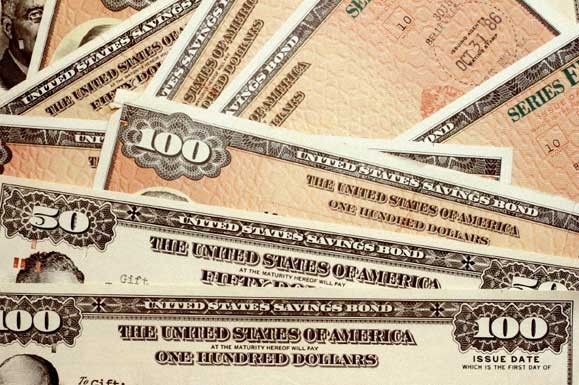Intro to Series EE Savings Bonds Investing
Post on: 22 Октябрь, 2015 No Comment

New Investor’s Guide to Series EE Savings Bonds
Savings bonds have been one of the most popular investments in the United States for more than a century. Of these, perhaps none is better known than the Series EE savings bond. Issued by the United States Treasury to help raise money to fund the government, Series EE savings bonds allow investors to buy bonds in much smaller denominations than traditional corporate or municipal bonds. which sometimes require $10,000 or $100,000 per bond.
How Series EE Savings Bonds Work
The Series EE savings bonds work differently depending upon whether you own electronic EE savings bonds or paper Series EE savings bonds.
Electronic Series EE Savings Bonds
- Electronic Series EE savings bonds are sold at face value. If you want to invest $50, you will receive a $50 electronic Series EE savings bond and it is worth full value when eligible for redemption.
- Electronic Series EE savings bonds can be purchased in amounts of $25 or more, to the penny. If you have $547.32 you want to invest, you can do that, making these a great choice for small investors with limited funds.
- Purchases of electronic Series EE savings bonds are limited to no more than $25,000 per calendar year.
- Electronic Series EE savings bonds are issued to a designated account. You will receive no physical paper bond.
Physical Paper Certificate Series EE Savings Bonds
- Paper Series EE savings bonds are sold at half of face value; if you buy a $5,000 face value bond, you will pay $2,500 in cash today.
- Paper Series EE savings bonds can be purchased in denominations of $50, $75, $100, $200, $500, $1,000, $5,000, and $10,000.
- There is a maximum purchase of $5,000 investment ($10,000 face value) per calendar year.
How Do I Buy Series EE Savings Bonds?
How You Make Money Investing in Series EE Savings Bonds
When you buy a Series EE savings bond, you are lending money to the United States government. From time to time, the government changes the rules on savings bond, so how your Series EE bonds work depends upon when you purchased them. According to the Treasury department, Series EE bonds purchased on or after May 1, 2005, earn a fixed rate of return, letting you know what the bonds are worth at all times. EE bonds purchased between May 1997 and April 30, 2005, are based on 5-year Treasury security yields and earn a variable market-based rate of return. In other words, the Series EE bond has become a fixed rate bond again since April 30, 2005. During the eight years prior, the bonds had variable interest rates, meaning that the investor wouldn’t know the rate of interest his or her bond would pay because it would change with overall interest rates. This can be good in times of inflation. bad in times of stable economic growth and low interest rates.
Series EE bonds are a type of zero coupon bond. With a traditional bond. you may invest $10,000 and earn 5% coupon per year. Each year, you collect $500 in interest income. In the U.S. companies typically make payments twice per year, so you’d receive $250 on June 30th, and $250 on December 31st. When the bond matured, you’d receive the face value of the bond ($10,000). With zero coupon bonds. in contrast, you never receive cash interest income. Instead, the bonds are issued at deep discounts to face value and have been calculated to compound to the point that they are worth the face value of the bond on the maturity date .
Maturity Date for Series EE Savings Bonds
Issue Date Original Term
Jan 1980 — Oct 1980 = 11 years
Nov 1980 — April 1982 = 9 years
May 1981 — October 1982 — 8 years
November 1982 — October 1986 — 10 years
November 1986 — February 1993 = 12 years
March 1993 — April 1995 = 18 years
June 2003 — Present = 20 years
In other words, if you were to buy a bond in January of 1983, the chart tells you that your maturity is 10 years; e.g. if you bought a $5,000 face value Series EE savings bond, you would pay $2,500 in cash and 10 years later (January, 1993), the bond would be worth full face value ($5,000). You would never actually receive any money in the mail, but instead, each year the value of the interest you were owed would be added to your bond so it increased in value. You have the option to continue holding the bond for up to 20 additional years, meaning that it could eventually be worth far more than face value; $20,000+ is possible. This point confuses a lot of new investors and it’s important for you to understand.
How Much Interest Will My Series EE Savings Bond Pay?
To learn how Series EE savings bonds interest rates are calculated, read Series EE Savings Bond Interest Rates.
Penalties for Cashing Out of Series EE Savings Bonds
If you sell your Series EE savings bonds back to the government within five years of investing, you lose the interest income you were owed for the most recent 3 months. If you redeem the bonds anytime after five years, there is no penalty and you receive the full value of the interest you are owed on the bonds.
Who Can Own Series EE Savings Bonds?
- Resident of the U.S.
- U.S. Citizen living abroad who still has a U.S. address of record.
- Civilian employee of the U.S. regardless of residence.
- Minor. U.S. Savings bonds, including the Series EE savings bonds, are the only security minors can own directly.














